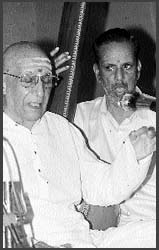
SEMMANGUDI SRINIVASA IYER

Srinivasa Iyer was the third son born to Radhakrishna
Iyer and Dharmasamvardhini Ammal. Born on 25th July
1908, he grew up in the village of Semmangudi which is in
the cradle of Carnatic music, Tanjavur District, South
India. No doubt this little village is now world renowned
due to Srinivasa Iyer. From the age of 5, the young lad
showed an aptitude and interest in music. The success in
the field of music by Dharmasamvardhini’s brother,
Tirukodikaval Krishna Iyer (one of the first successful
Carnatic musicians who played violin), and her nephew
Narayanaswami Iyer, led Radhakrishna Iyer to decide
that music would be a good career for his son. Hence
from the age of nine, Semmangudi started receiving music
training.
Semmangudi had the opportunity to learn music under four distinguished musical
stalwarts. He started his musical training in 1917 (on the auspicious Vijayadasami
day) with his cousin-brother, Sri Semmangudi Narayanaswami Iyer, who was a
violinist. Later he had the opportunity to study music with the eminent gottuvadhyam
artiste, Sakharama Rao, and also vocalist Sangeetha Kalanidhi Sri Umayalpuram
Swaminatha Iyer. The latter had learnt music from direct disciples of Thyagaraja.
Finally, Semmangudi had training from the acclaimed vocalist, Sangeetha Kalanidhi Sri
Maharajapuram Viswanatha Iyer, also a disciple of Swaminatha Iyer. Semmangudi
had the chance to provide vocal support to Viswanatha Iyer in several concerts. The
style of tuition, under each of his four gurus, always in the gurukula tradition where
the student lived with the teacher, ensured the best environment to learn music.
Semmangudi’s rise to fame was quite meteoric. In the late 1930s he was considered
as one of the front line vocalists of the period and in 1947, the Music Academy of
Madras awarded him the title Sangeetha Kalanidhi. Aged 39, he was the youngest
artiste to receive the award. Today he is the oldest surviving Sangeetha Kalanidhi.
During his illustrious career, Semmangudi held many notable positions. In 1939 he was
made Asthana Vidwan (resident musician) of the Travancore Palace in Kerala and
joined the Swati Tirunal Music Academy in Trivandrum in 1941. He soon became the
Principal of this institution and was there till 1963. From the period 1956-59, taking a
leave of absence from the Academy, he also served as Chief Producer of Carnatic
Music at All India Music, Madras.
Part of his role at the Swati Tirunal Academy was to revive the compositions of
Maharaja Swati Tirunal. For many of the compositions, the text was available but
there was no indication about the tune. Semmangudi, along with Harikesanallur
Muthiah Bhagavathar and others were given the task to set music to the Maharaja’s
lyrics. Semmangudi has brought out two publications which give the notation to over
200 of Swati Tirunal’s compositions. Furthermore, he tried to include at least two
Swati Tirunal compositions in each of his concerts. Deva Deva
(Mayamalavagowla), Pankajalochana (Kalyani) and Bhavayami Raghuramam
(Ragamalika) are just some of the compositions that were both tuned and popularised
by him. The latter, a description of the epic Ramayana, was originally entirely set in
Saveri raga but Semmangudi transformed it into a ragamalika (beginning with Saveri)
and added a scintillating set of chitta-swarams.
Semmangudi has large set of prominent disciples, some of whom did gurukulavasam,
others whom he taught while at the Swati Tirunal Academy and others who took
casual lessons with him. His prominent disciples include two Sangeetha Kalanidhi-s:
Prof. T. N. Krishnan (who accompanied him on violin in many concerts) and T. M.
Thiagarajan. Disciple P. S. Narayanaswamy is a well respected musician.
Kallidakurichi S. Harihara Iyer had a long association with Semmangudi and also
became the Principal of the Swati Tirunal Academy. Another disciple, K. R.
Kumaraswamy Iyer also held the same position. Other notable disciples include Palai
C. K. Ramachandran and V. Subramaniam (both of whom still provide vocal support
to Semmangudi), Neyatinkara Vasudevan, Vaigal Gnanaskandan, Parasala
Ponnammal and K. Omanakutty. M. S. Subbulakshmi and K. J. Yesudas (a Music
College disciple) have also learnt many compositions from Semmangudi.
The music of Semmangudi has a certain magnetism about it. In his concerts, he
generally has concentrated on krithis, neraval and swaram singing rather than
elaborate raga alapanas, which are generally neat and succinct. His exuberant singing
of adjacent swaras in rapid succession is prominent element of his unique style. His
brilliant exposition of Kharaharapriya raga led people to refer to him as
‘Kharaharapriya Srinivasa Iyer’.
Semmangudi’s repertoire consists of some 800 compositions. He has sung varnams in
his concerts on a few occasions but generally chooses to commence with a krithi in
Mayamalavagowla or a Ganapathi krithi.